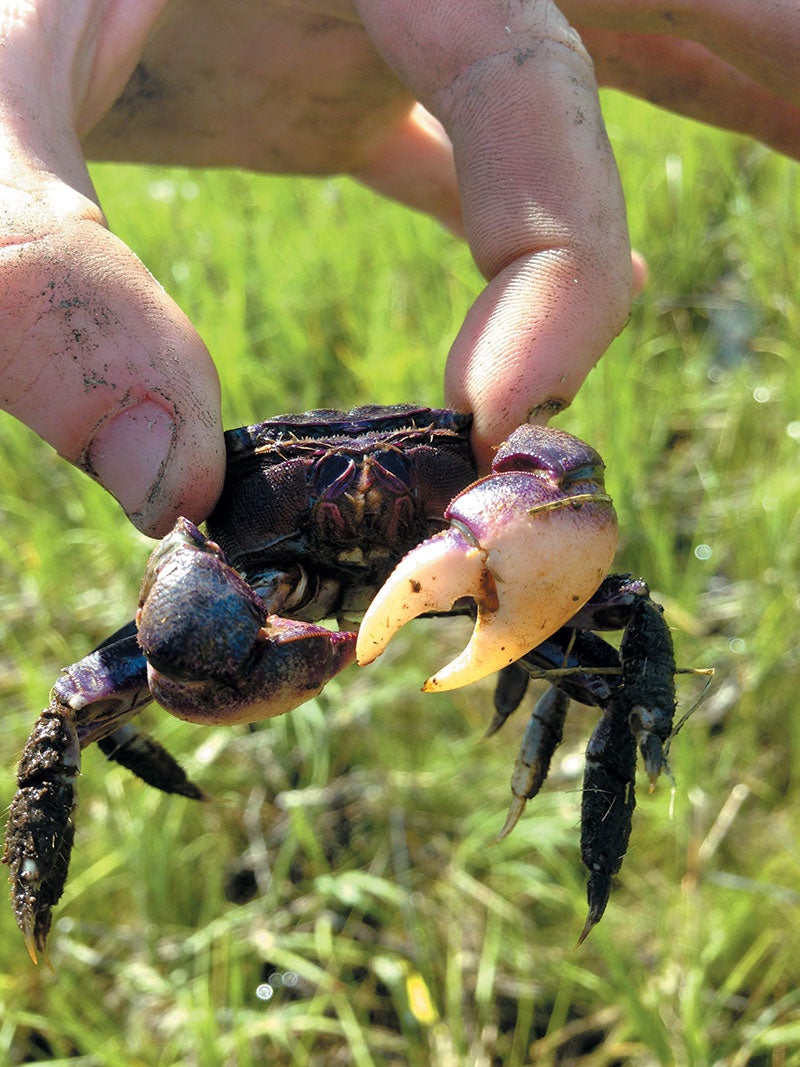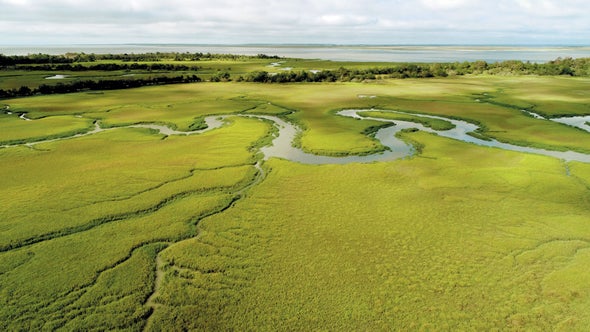Halfway down Georgia's coastline, Sapelo Island is surrounded by more than 4,000 acres of salt marshes, with vast stretches of lush grasses that blaze gold in the colder months. But this beautiful barrier island is experiencing some of the harshest effects of climate change: seawater intrusion, intense storms and flooding.
And scientists have noticed something more subtle and unusual happening to the island in the past several years. A once inconspicuous burrowing crab is suddenly wiping out swaths of marsh cordgrass, a plant that holds much of the South's coastal marshland in place and protects vulnerable species. The tiny purple marsh crab, Sesarma reticulatum, seems to be reshaping—and fragmenting—the island's marshes.
Sinead Crotty, an ecologist and project director at Yale University's carbon-containment laboratory, used aerial images to document the crab's impact on marshland along the U.S.'s southeastern coast. To investigate the cause of the changes, Crotty and her colleagues combined analysis of the aerial imagery with historical tide data and numerical models of sea-level rise.

Their results, published in the Proceedings of the National Academy of Sciences USA, show the crabs are altering salt marshes' response to sea-level rise by gorging on cordgrass at the heads of tidal creeks. The researchers say rising water levels caused by climate change have softened marsh soil, creating optimal burrowing conditions for the crabs. The crabs' increased activity then results in longer and broader creeks that drain the marshes into the ocean. Over years this process transforms marshes from contiguous grasslands into patches fractured by crab-grazed creeks.
This finding challenges the long-standing paradigm that only water flow, sediment, plants and human activity—not animals—shape how salt marshes respond to sea-level rise. The researchers say this crab may be the first identified organism to reach the status of a keystone species, an organism that has disproportionate importance and influence in its ecosystem, because of climate change. It is unlikely to be the last.
Crotty says it is mind-boggling that “this very small organism, an inch or two in diameter, can alter something as large as an entire marsh landscape visible from Google Earth images.”
Scientists working on Georgia's coast already knew Sesarma crabs were enlarging tidal creeks by grazing cordgrass, says Merryl Alber, director of the University of Georgia Marine Institute on Sapelo Island. But this new work suggests the crabs' actions may be accelerating the long-term loss of the marsh to rising seas. “This shows that our marshes may be more vulnerable than we thought,” she says. Alber was not directly involved in the study, but the institute provided logistical support to the research team.
Crotty first encountered Sesarma as an undergraduate in co-author Mark Bertness's Brown University lab. In 2011 Bertness's team discovered that the crabs were behind sudden marsh die-offs on Cape Cod, after overfishing had diminished predator populations such as striped bass. Marsh soils farther south had previously been too hard for the crabs to gain a significant claw-hold, and Crotty and her colleagues wondered if sea-level rise could be making them softer.
The team analyzed tidal data and found that southern marshes are now submerged up to an hour longer a day than they were in the 1990s. The researchers say this process has indeed softened the soil, helping the burrowing crabs thrive. Aerial photographs along the U.S.'s southeastern coast indicate the number of Sesarma-grazed marsh creeks increased by an average of two and a half times from the 1990s to late 2010s. In study areas, the team found that the rapid expansion of crab-grazed creeks increased drainage of the marsh by up to 35 percent.
By wiping out cordgrass, crabs also destroy protective cover for ecologically critical animals, including snails and other mollusks. The researchers checked predation levels on Sapelo Island by tethering snails and mussels to fishing line near grazed and ungrazed creeks. They found this loss of cover can make small invertebrates—which provide food to commercially important species such as blue crab and redfish—more vulnerable to predator feeding frenzies, Crotty says, potentially disrupting entire ecosystems.
Human activities are resetting which species hold the most sway over ecosystem behavior, says Christine Angelini, an ecologist at the University of Florida and principal investigator for the study. Because of overfishing and climate change, she observes, purple marsh crabs are “wreaking havoc everywhere” across their range.
Climate change has given several species a dangerous advantage. Ocean warming and acidification make it easier for predators such as sea urchins to gnaw away at coral. Native plants are losing ground to exotic varieties that can bloom earlier as weather warms. Higher temperatures in the Caribbean could help invasive, reef-destroying lionfish expand their range there. But scientists have not previously documented such organisms exerting the kind of influence purple marsh crabs do over the way an ecosystem functions, from its actual shape to the interplay between predators and prey.
“I have no reason to doubt that climate change will alter species' interactions such that new keystone species emerge,” says Linda Blum, an ecologist at the University of Virginia, who was not involved in the study. But, she adds, the team's conclusion that sea-level rise creates new crab habitat by softening marsh soil is built on “a lot of circumstantial evidence.” She suggests it should be tested with field experiments to determine whether the crabs' own activities could contribute to easier burrowing.
Now the researchers are investigating how increased activity from Sapelo Island's Sesarma crabs might be exposing buried carbon to the air, as well as if the crabs are raising concentrations of contaminants from a nearby superfund site by accumulating these chemicals in their bodies.
More work is also needed to understand whether the crabs are influencing how quickly seas move inland, Angelini says: “We don't know if it's the first step toward, ultimately, the marsh drowning or if marshes will stay stable and persist for decades in this fractured state.”

